In 1935, at the
height of the Depression, a group of New York businessmen decided
that what the city and the nation needed to lift itself out of the
difficulties of the times was an international exposition. They
promoted it as the greatest international exposition in history—a
world's fair that will be easy to see, easy to understand, easy to
like, easy to get to. It was to be a testament to the future—a
celebration of Art Deco and the age of industrial design.
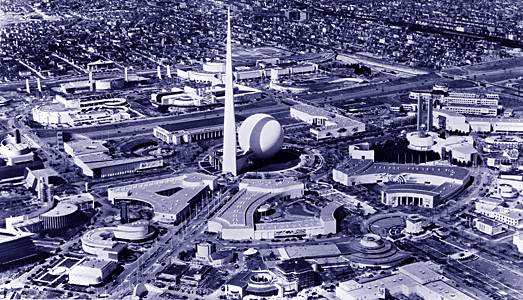
Grover Whalen was in charge of marketing. He brought 60 nations and
international organizations to the Fair, as well as 33 states and
territories of the United States. He also marketed the Fair
aggressively to the American public, promoting it in print, radio,
and above all newsreels. In fact, it was difficult to tell where the
line between reality ended and the publicity stunt began. He even
commissioned Howard Hughes to deliver invitations to the nations of
the world during his famous around-the-world flight. He also had the
Trylon and Perisphere—the symbols of the Fair—painted on the sides
of the plane.
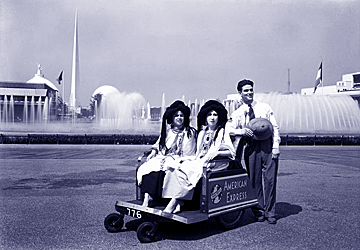 Robert
Moses, who later became famous as the organizer of the 1964/65 New
York World’s Fair, insisted that the Fair organizers create a new
park site on a trash heap in Flushing Meadows, Queens—a statement
about the promise of tomorrow to repurpose the trash of the past.
The Fair covered 1,216 acres. Only the 1904 St. Louis World’s Fair
was larger.
Robert
Moses, who later became famous as the organizer of the 1964/65 New
York World’s Fair, insisted that the Fair organizers create a new
park site on a trash heap in Flushing Meadows, Queens—a statement
about the promise of tomorrow to repurpose the trash of the past.
The Fair covered 1,216 acres. Only the 1904 St. Louis World’s Fair
was larger.
The size of the fair required a trolley system and manned push-carts
in which visitors could relax while crossing the fair’s grounds.
Like many of the massive world’s fairs of the 19th and early 20th
century, the Fair was organized around a momentous historic
occasion. The 1893 World’s Columbian Exposition in Chicago
celebrated the 400th anniversary of Columbus’ arrival, but the 1939
fair was to commemorate the 150th anniversary of George Washington’s
presidential inauguration in New York, then the capital of the
United States.
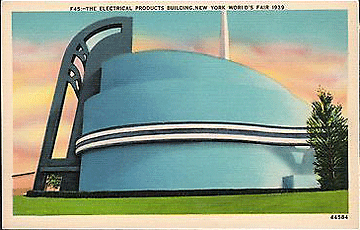 But
although Whalen wanted to look back to the past, the Fair’s
designers were looking to the future—“The World of Tomorrow”—created
as a display of Modernism and the streamlined motif by the leading
industrial designers of the day, Norman Bel Geddes, Raymond Loewy,
Henry Dreyfuss, and Walter Dorwin Teague. The persuaded the American
corporations exhibiting at the Fair that the simplified beauty of
Art Deco could seel their products.
But
although Whalen wanted to look back to the past, the Fair’s
designers were looking to the future—“The World of Tomorrow”—created
as a display of Modernism and the streamlined motif by the leading
industrial designers of the day, Norman Bel Geddes, Raymond Loewy,
Henry Dreyfuss, and Walter Dorwin Teague. The persuaded the American
corporations exhibiting at the Fair that the simplified beauty of
Art Deco could seel their products.
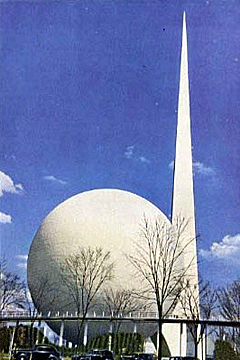 The
designers used the Fair to promote the clean lines and pure forms
demonstrated in commercial products, such as automobiles,
toothbrushes, and airplanes. They all leaned heavily towards
socialism. Bel Geddes even boasted that he would design “social
structure” in objects of daily use. These men believed in clean,
rational design for all of society. The designers also established a
relatively low maximum line of height for the buildings, save for
structures like the Trylon and the Soviet pavilion, in order to
allow visitors to view the fair’s architecture against the backdrop
of "Manhattan's spires."
The
designers used the Fair to promote the clean lines and pure forms
demonstrated in commercial products, such as automobiles,
toothbrushes, and airplanes. They all leaned heavily towards
socialism. Bel Geddes even boasted that he would design “social
structure” in objects of daily use. These men believed in clean,
rational design for all of society. The designers also established a
relatively low maximum line of height for the buildings, save for
structures like the Trylon and the Soviet pavilion, in order to
allow visitors to view the fair’s architecture against the backdrop
of "Manhattan's spires."
The Fair’s organizers hired such noted architects as Alvar Aalto and
Skimore and Owings. They divided the Fair into seven
zones—Transportation, Government, Communications and Business
Systems, Community Interests, Food , Production and Distribution,
and Amusements—plus a Theme Center to make it easier for fairgoers
to navigate the grounds.
The organizers also color coded the different sections of the Fair
to create a visible navigation system. With the Theme Center as the
only stark white area, the main axis as shades of red, the Avenue of
Patriots as primarily yellow, and blue for the Avenue of Pioneers,
with a passage of varying colors connecting the three ends of the
Mall and avenues, named Rainbow Avenue. "Bright, colorful, and
inventive" lighting was encouraged for the exhibitions at night, but
it was required to be restrained so that the floodlighting of the
Perisphere and the searchlight canopy over the Court of Peace were
emphasized, except for the fireworks and special light shows which
were to be displayed nightly. In addition, sound was regulated to
the point that no "outside spiels" could be displayed unless crucial
to the exhibition.

The Fair opened on
April 30, 1939, ushered in by Franklin Delano Roosevelt and
displayed on the medium of the future, television in its first day
of public broadcasting in New York City.
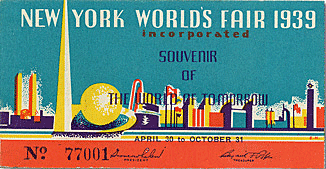 Paid
admission that day numbered 198,791, with general admission costing
75 cents for adults and 25 cents for children ages 3 to 14. The
admission fee was considered fairly high in its day, since the
subway ride to the fair cost 5 cents. separate admission charges
were required for roughly one-fourth of the fair’s exhibits.
Paid
admission that day numbered 198,791, with general admission costing
75 cents for adults and 25 cents for children ages 3 to 14. The
admission fee was considered fairly high in its day, since the
subway ride to the fair cost 5 cents. separate admission charges
were required for roughly one-fourth of the fair’s exhibits.
Each day parades and fireworks highlighted the fair’s activities,
designed to draw visitors from across the nation and the world.
Whalen and La Guardia in particular continued to aggressively market
the fair in the media, posing with guests as well as with sponsors
of exhibits, such as Henry Ford on Ford Day .
The 1940 Fair
But things changed drastically by the time the Fair was to open on
May 11, 1940. Europe was well into the second World War. The Soviet
pavilion was gone, replaced by the "American Common." Fountain Lake
in the Amusements Area had been renamed Liberty Lake. The British,
Polish, Czechoslovakian, and Finnish pavilions had reminders of the
war in their exhibits. Norway and Denmark were only minimally
represented the second summer. In June of that year France fell to
Germany. Gibson, in the business of promoting international
cooperation and the benefits of technology for tomorrow’s America,
obviously had his work cut out for him. The mind of the nation was
no longer on the future of the 1960s but on the possibility of war.
The momentum of April 1939 and the allure of the new had subsided.
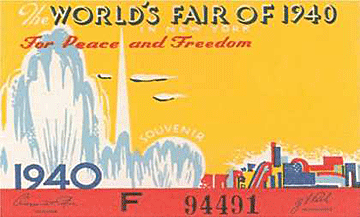 But
regardless of how exciting the Fair was in 1939, it didn’t live up
financially to the hopes of its organizers. When the 1940 Fair
opened, adult admission had been reduced to 50 cents per person. It
also had a new business manager, Harvey Dow Gibson, who brought in
“rowdier” amusements and renamed the Amusement Area the “Great White
Way.” He even changed sensationalized the language in the Official
Guidebook.
But
regardless of how exciting the Fair was in 1939, it didn’t live up
financially to the hopes of its organizers. When the 1940 Fair
opened, adult admission had been reduced to 50 cents per person. It
also had a new business manager, Harvey Dow Gibson, who brought in
“rowdier” amusements and renamed the Amusement Area the “Great White
Way.” He even changed sensationalized the language in the Official
Guidebook.
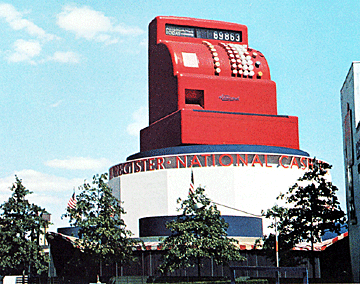 The
fair closed on October 27, 1940, having drawn approximately 45
million admissions and 48 million dollars. Unfortunately, the Fair
Corporation itself had invested 67 million dollars of the roughly
160 million dollars used for the original construction, promotion,
and operation of the fair. What Whalen called "the greatest civil
engineering feat of the century" had failed economically.
The
fair closed on October 27, 1940, having drawn approximately 45
million admissions and 48 million dollars. Unfortunately, the Fair
Corporation itself had invested 67 million dollars of the roughly
160 million dollars used for the original construction, promotion,
and operation of the fair. What Whalen called "the greatest civil
engineering feat of the century" had failed economically.
The history of the 1939 New York World’s Fair is, in a sense, the
history of the transformation of the American sensibility, from a
late-Depression-era futuristic vision to the one of apprehension and
anxiety which characterized the pre-World War II period. It has
served as a model for future world’s fairs, and its exhibits and the
people involved with it profoundly influenced movements in design,
art, architecture, advertising, marketing, urban development, and
cultural studies. It was and remains a cultural icon, an
encapsulation of a period of tension and possibilities in the
history of American culture.
The Promise of Tomorrow
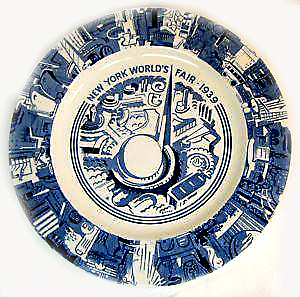 The
fair had marketed its message well in the press and in an infinite
number of commercial products, from playing cards and board games to
household items such as soaps, glasses, plates, and radios, most of
which displayed the Trylon and Perisphere. The fair had attempted to
transform itself into the literal world of the future by providing a
very clear vision of the chaos of the past and the purity and peace
of a socially-planned future.
The
fair had marketed its message well in the press and in an infinite
number of commercial products, from playing cards and board games to
household items such as soaps, glasses, plates, and radios, most of
which displayed the Trylon and Perisphere. The fair had attempted to
transform itself into the literal world of the future by providing a
very clear vision of the chaos of the past and the purity and peace
of a socially-planned future.
The futuristic vision of perfection embodied by The World of
Tomorrow is perhaps best exemplified in a film entitled The City,
based on the writing of Pare Lorentz and produced for the American
Association of Planners. Lorentz’s City offered an apocalyptic
vision of contemporary urban life in America and claimed the
solution to its woes rested in Mumford’s greenbelt communities. The
rhetoric of the film attempted to sell the idea of anti-urban
regional planning which in fact as come true in the 21st Century.
Thought the Fair became a cultural phenomenon and a highly
successful media event, many of the 45 million visitors to it didn’t
buy the corporate message of the future and basically looked at it
as pure spectacle and entertainment.
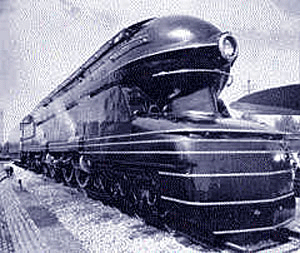 Gibson
noted that not only was the Fair too pricey for its target
audience—the combined cost of an admission ticket and a tour of the
most popular exhibits would be nearly $100 today—thus driving away
the “folk” for whom the organizers created the Fair. Furthermore,
few of the multitudes entering the gates had any desire or means to
purchase things like T.V. sets or cars to ride the superhighways of
the future. For them, the Fair was a respite from the long, hard
years of the Great Depression. Basically, Americans were not ready
for the radical world of tomorrow that the Fair portrayed.
Gibson
noted that not only was the Fair too pricey for its target
audience—the combined cost of an admission ticket and a tour of the
most popular exhibits would be nearly $100 today—thus driving away
the “folk” for whom the organizers created the Fair. Furthermore,
few of the multitudes entering the gates had any desire or means to
purchase things like T.V. sets or cars to ride the superhighways of
the future. For them, the Fair was a respite from the long, hard
years of the Great Depression. Basically, Americans were not ready
for the radical world of tomorrow that the Fair portrayed.
The World of Tomorrow was intended to be a clear demonstration of
how life was going to be in the United States and in the rest of the
world from that point forward. the fair was, in the end, an
amusement show with a message. The World of Tomorrow promised a
worldview of a society dominated by leisure and abundance granted by
the use of technology, and in many ways the fair’s visitors and
scholars have seen it fulfill its prophecy.
